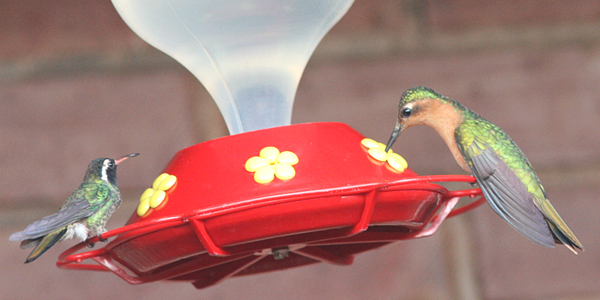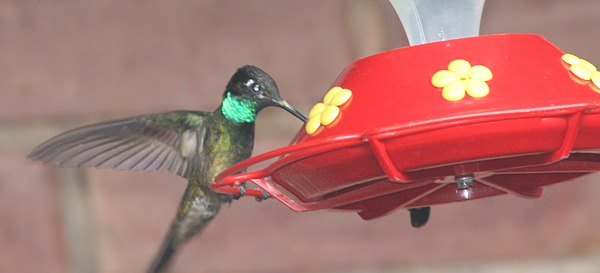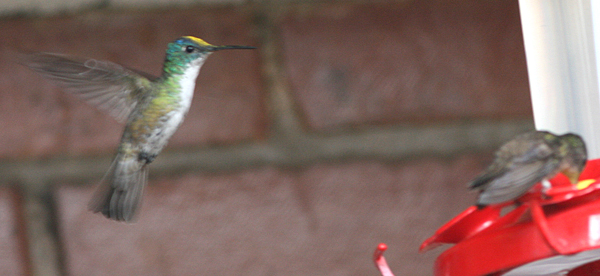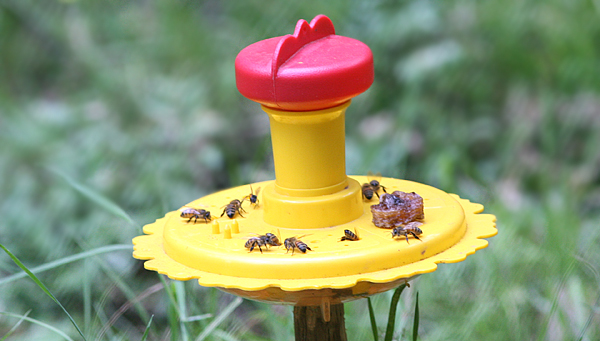Guatemala’s current capital, Guatemala City and colonial capital, Antigua both lie in the central highlands. Most of this vast region is between 2000 and 4000 meters above sea level and characterized by cool mountain forest habitat. Apparently, it’s also magic for hummingbirds.
I’ve previously encountered the typical feeder hummingbirds of this region working the noble array of nectar wells at Finca El Pilar. I also had the good fortune to find some busy feeders at Cabana Suissa in the Antigua area. The same brilliant hummers seem to turn up again and again at sugar stations throughout the region, great news for anyone interested in enjoying the kinetic kaleidoscope of these jewel-toned jousters at work.
Sabrewings are a big hit at Guatemala feeders in more ways than one. Not only are they often the brawniest birds sipping at the sweet stuff but they also don’t mind throwing that bulk around. Named for their long, scythelike wings, sabrewings also flaunt wicked curved bills. The Rufous Sabrewing (Campylopterus rufus) appears in pleasing shades of jade and rust while the male Violet Sabrewing (Campylopterus hemileucurus) looks deep indigo in most lights.
White-eared Hummingbirds (Hylocharis leucotis) are conspicuous by their telltale ivory auricular markings. Males are boldly marked with red bills, malachite throats, and faces of such deep violet that they often appear black. These lovely hummers seem to get around as they turn up all over the central and western highlands.

White-eared Hummingbirds are mid-sized hummers but totally dwarfed by Rufous Sabrewings
Berylline Hummingbirds (Amazilia beryllina) clad in emerald and rufous exhibit a propensity for perching on slender bare branches, a habit shared by the closely related but more variegated Blue-tailed Hummingbird (Amazilia cyanura). The blue-tail’s puffy white leg plumage looks like boots to some but when I look, I see legwarmers. As an aside, A. beryllina is named for the stone beryl which, though colorless in its pure form, is often identified with a dazzling green.

The Magnificent Hummingbird (Eugenes fulgens), bigger than the Berylline, earns its moniker in the right light. When the sun catches a male’s electric turquoise gorget and violaceous crown, look out! In shade, the Magnificent appears rather dark but stands out because of its size and bright post-ocular spot.
The blue of an Azure-crowned Hummingbird’s (Amazilia cyanocephala) head can be rather subtle. In fact, its white belly is more of a field mark. The bird in the blurry photo below looks more like a canary-crown because of the pollen dusting its dome. Some hummingbirds can be potent pollinators.

Levitating lovelies like Green Violetear (Colibri thalassinus), Sparkling-tailed Woodstar (Tilmatura dupontii) and Slender Sheartail (Doricha enicura) can turn up at same feeders as well. Away from feeders, other hummers like Green-throated Mountain Gem (Lampornis viridipallens) enter the mix. My experience though is that if, while visiting the Guatemalan highlands, you park yourself where the sugar water is flowing, you’re bound to see most or all of the amazing aforementioned hummingbirds.
…and whether you hold that great minds think alike or that fools seldom differ, you may be as pleased as I am to find that Rick Wright has also shared his own keen observations of Guatemala Highland hummingbirds!

Protect your bird feeders by deploying bee feeders!











Great hummer shots Mike. I’m really loving the beginning of Mesoamerican Month. I can’t wait to read the rest!
Great photos, Mike! And I prefer to think that we’re just tapping in to the same universal consciousness. Or something. 🙂
r